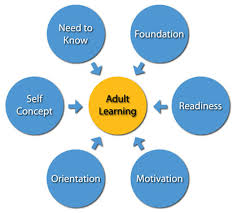Week 1: Blog Reflection “Androgogy: The Structure & Process for Engaging Adult Learners”
Month: June 2013
Andragogy: The Structure & Process of Engaging Adult Learners
 Yesterday, the principal’s at a school I serve addressed his leadership team about the critical importance of raising the graduation rate. “Everything we do,” he said, “must lead back to helping our students get to graduation.” This year, just 46% of their seniors crossed the finish line. There was a time in my life when I was dangerously close to joining the statistics of those who failed to finish. It wasn’t because I wasn’t bright or curious. But by age 13, I thought of schools as baby sitting centers and was totally unengaged.
Yesterday, the principal’s at a school I serve addressed his leadership team about the critical importance of raising the graduation rate. “Everything we do,” he said, “must lead back to helping our students get to graduation.” This year, just 46% of their seniors crossed the finish line. There was a time in my life when I was dangerously close to joining the statistics of those who failed to finish. It wasn’t because I wasn’t bright or curious. But by age 13, I thought of schools as baby sitting centers and was totally unengaged.
As these stories often unfold, the point of pain becomes a driving force in ones life. So now, I spend my days working to improve the student experience in our public schools by coaching teachers to integrate technology into their classrooms. The use of technology in education is not just to utilize this digital social currency, but also to create learning opportunities that might otherwise be impossible to manage. I envision high schools as a place were we prepare students to be life long learners: setting personal goals, problem-solving, and finding real world relevance in the act of studying.
Malcolm Knowles, a man credited for making the distinctions between Adult and child education popular today, lays out six assumptions about adult learners. These assumptions say that learners adult learners are 1. self-directed, 2. enriched and informed by their personal life experience, 3. that readiness to learn is influenced by the relevancy of the topic to the individual’s circumstances, 4 that their motivation level seeds from a need to apply the learned skills immediately, 5 that their motivation is anchored in increasing self-esteems and accomplishing goals, and 6 that adults learn best when they understand why the information is pertinent. (Forrest III & Peterson, 2006; Kidd, 1973; Knowles, 1984a, 1984b; Knowles et al., 1998; Lindeman, 1926; Ozuah, 2005; Thompson & Deis, 2004)
In looking at Knowles’s characteristics of adult learners, I wonder if our failure to recognize these as more general characteristics of learners accounts for the over 3 million students who dropped out of school last year. According to Taylor and Kroth (2009), Andragogy faces several criticisms. Among them are a lack of ability to be measured, inability to define clear procedures of andragogical practices, that andragogy means a lack of testing and grades and is therefore impossible to measure, and that these characteristics are not always found in adults and are sometimes found in children.
I believe that technology used to capture and study learner analytics can play a critical role in developing ways to measure learner characteristics above and beyond grades and tests. I also think that all educational experiences have more value when students of any age understand why the learning task is relevant and related to personal growth. Based on my own experience, I agree with the criticism that these “adult characteristics” are not just limited to adults. My own critic of my education experience of at a young age demonstrate that I exhibited these “adult learner characteristics” even with limited life experience. As with all learning theories, from behaviorism to constructivism, each carry some truth about learners, not in isolation but woven together to understand the complexity of the human brain. By understanding the characteristics of such theories, they enable us to reach more learners by designing more relevant and engaging learning experiences.
References
Taylor, B & Kroth, M. (2009) Andragogy’s transition into the future: meta-analysis of andragogy and its search for a measurable instrument. Journal of Adult Education, 38 (1).
